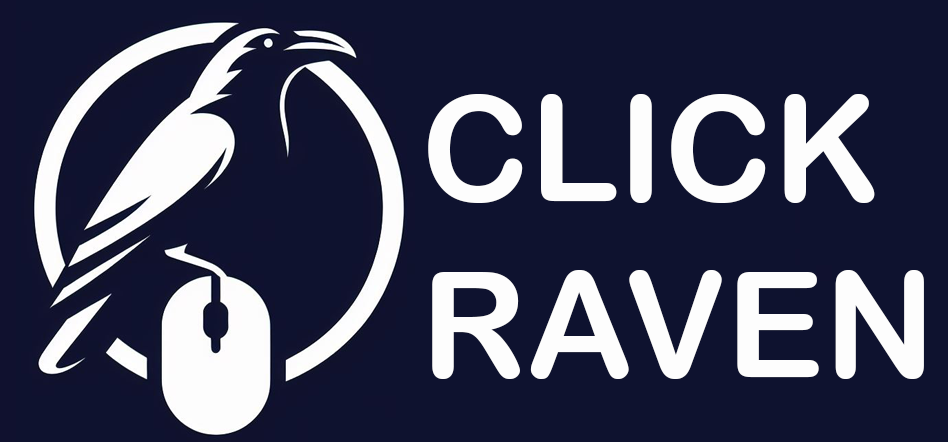Free Referring URLs & Domains Checker
Find your top referring URLs, websites, and pages in seconds.
No sign-up required. Download the list to CSV or copy the list to your spreadsheet for free for further analysis.
How it works
Submit your website URL
Enter your website URL in our tool and click submit.
Instant referring websites generated
Our tool will generate your website’s referring URLs and domains instantly with their domain authority.
Copy or download your free report
Once generated, copy to a document or download the referring websites report in CSV format.
Why use Clickraven’s Referring Websites Checker?
✔ It’s Free. No Signup Required – Generate your top referring websites directly in your browser without signing up to any platform.
✔ High-Quality Referring Websites – A full list of your top 200 referring websites
✔ Referring Websites Metrics – Each referring URL includes the total backlinks to your site, how many of those are dofollow, and Domain Authority of referring websites
✔ Download for Free – Copy the list to a document or download the full list in CSV format.

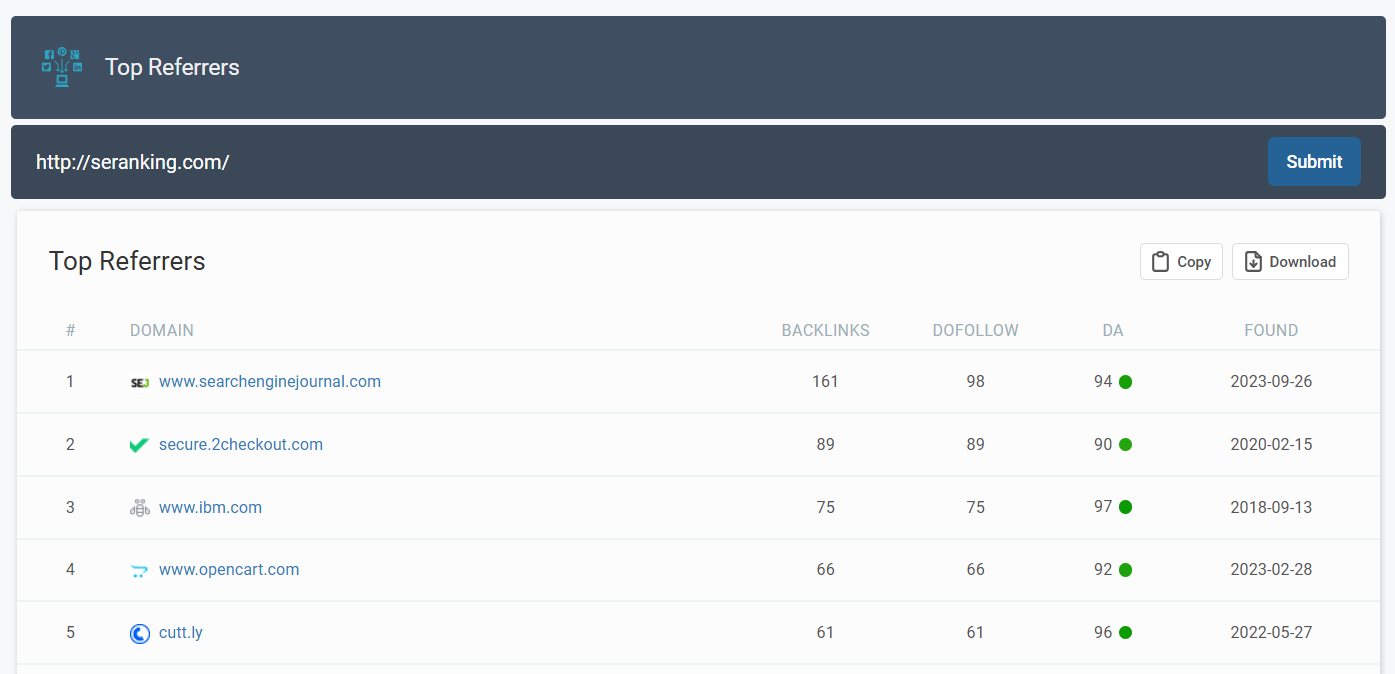
More than just a referring Domains checker
Clickraven offers a suite of free powerful SEO tools to help you optimize your website for search and AI visibility. Looking for more? Check out these additional tools:
✔ Keyword Density Checker – Find out the number of of times your target keyword appears in your content when compared to your total number of words.
✔ Keyword Research Tool – Discover more keywords you can target in your content for free.
✔ Meta Tags Extractor – Extract meta tags from any website’s HTML code for free.
✔ Crawlability Checker – Check if your website is crawlable and extract the code in your robots.txt file.
The Ultimate SEO Guide to Referring Websites & Domains
In Search Engine Optimization (SEO), a significant portion of your site’s authority and traffic is determined by external factors, chief among them being who is sending links and traffic your way. The websites that are linking to you are what we call “referring websites” because they refer to you:
- Authority – through backlinks
- Traffic – if the visitors on that website click on the target link and land on your website
Understanding your referring websites is important because:
- It tells you where your visitors come from,
- what content they find valuable,
- which other sites vouch for your credibility
In this guide, you will learn how to interpret referral data, transforming raw analytics into a powerful strategy that boosts your rankings, builds valuable partnerships, and drives meaningful traffic
Understanding Referral Data: URL vs. Website vs. Page
While often used interchangeably, the terms referring URL, page, and website are different things.
Referring Website (or Referring Domain):
This is the overall website that the link came from.
For example, if you receive a link from an article on Forbes, the referring website is forbes.com.
This top-level domain gives you context about the source’s overall authority, relevance, and reputation.
Referring URL (or Referring Page)
This is the specific, exact web page that contains the link to your site.
Following the example above, this would be the full URL, such as forbes.com/sites/username/2025/06/10/your-industry-trends.
This level of detail is critical because it shows you the context of the link.
Was it in an article, a list, a resource page, or a directory? The context of the page tells you why they linked to you.
Alongside these, two other terms are central to the conversation:
Backlink
This is the actual clickable hyperlink () on the referring page that points to your website.
Referral Traffic
These are the human visitors who actually click on a backlink from a referring URL and land on your website.
Why Referring Websites are Important for SEO
Analyzing your referring websites reveals actionable insights that you can use to grow your website’s organic rankings.
Here are the actionable insights you will get from your referring websites data:
1. Website Authority
Your list of referring websites is a direct reflection of your site’s authority.
The more high-quality referrers you have, the more trustworthy your site appears to Google and AI Search engines, leading to better search rankings.
2. Content Value
By analyzing which of your pages receive the most links, you can identify your “link-worthy” assets.
Do users frequently link to your statistical round-ups, your in-depth case studies, or your free digital tools?
This feedback shows you which of your content resonates enough for someone to endorse it with a link.
3. Outreach Opportunities
Your referral list is a pre-vetted list of potential partners who have demonstrated a clear interest in your niche and your content’s value.
This makes them warm leads for deeper collaborations, such as guest posting, co-branded content, or affiliate marketing.
4. Competitor analysis
By using SEO tools to analyze your competitors‘ referring websites, you:
- Identify authoritative sites in your industry that are open to linking to content like yours
- Uncover link-building opportunities you may have missed
- Find out their content strengths, giving you a chance to create something even better and with more value
A Practical Guide to Analyzing Your Referring Websites
Transforming referral data into actionable insights requires a systematic approach. Follow these steps to move from raw numbers to strategic decisions.
Step 1: Gather Your Referral Domains Data
To get a complete picture, you need to consolidate data from a few key sources:
Clickraven’s Referring Domains Checker:
Clickraven offers a free referring domains checker that helps you to find your the top domains that link back to your website.
Go to Clickraven's referring URLs checker > submit your website > get the free report.
You can download the report in a CSV format or copy the details into a document.
For instance, I asked Clickraven’s referring domains checker for the top referring websites of Search Engine Journal.
Here is a screenshot of the detailed report:
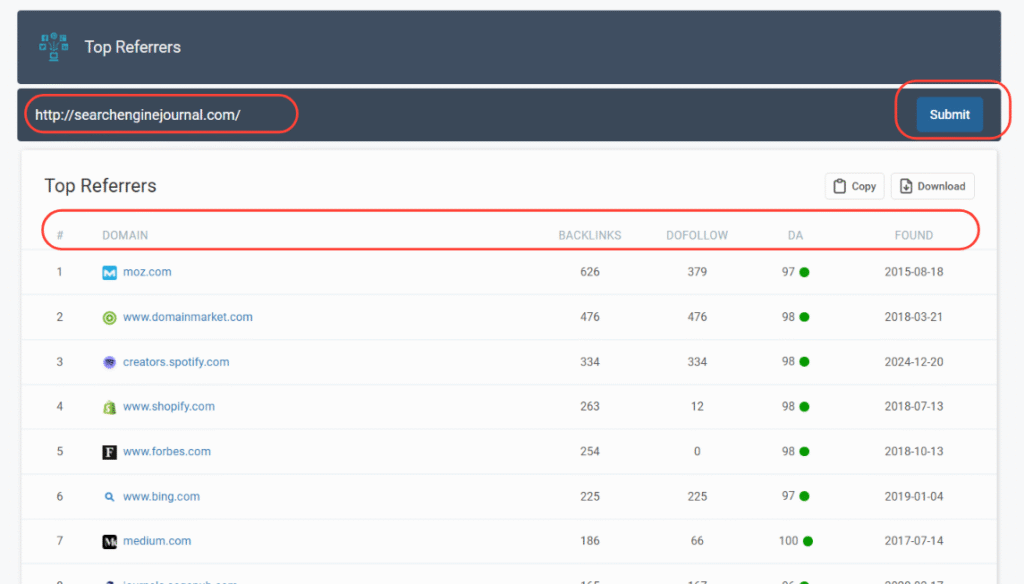
Clickraven’s SEO tool gives us the report with the details below:
- The Domain name
- The number of backlinks that domain is sending to the target website
- How many of those backlinks are dofollow
- The domain authority of the referring domain
- When the referring domain was first spotted
Google Analytics 4 (GA4):
The best source for understanding the traffic generated by your referrers. Navigate to Reports > Acquisition > Traffic acquisition.
For example, here is the screenshot of referral websites from the Google Analytics of one of our sites.
The websites marked inside the red rectangle represent referral website traffic to this website.
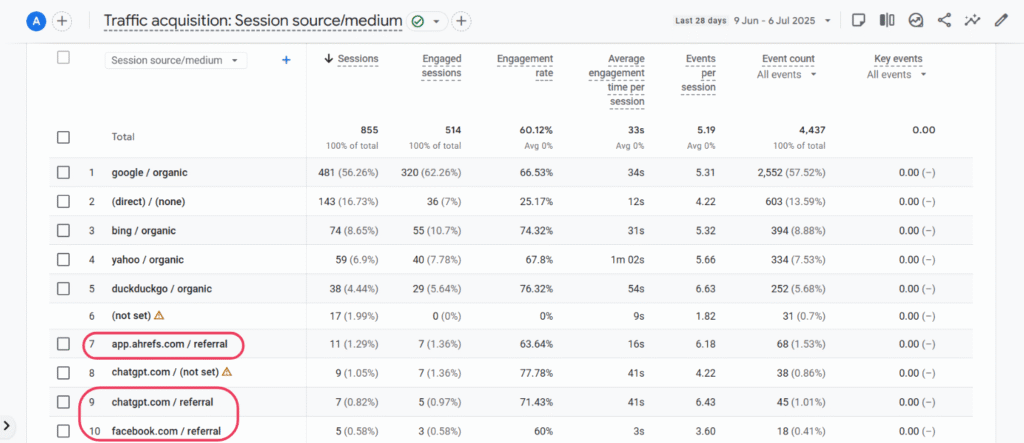
Here, you can see which referring websites send you the most users, their engagement rates, and conversions.
Google Search Console (GSC)
GSC provides direct data on your backlink profile from Google’s perspective.
To find your top linking domains, go to your search console and navigate to Links > Top Linking Sites.
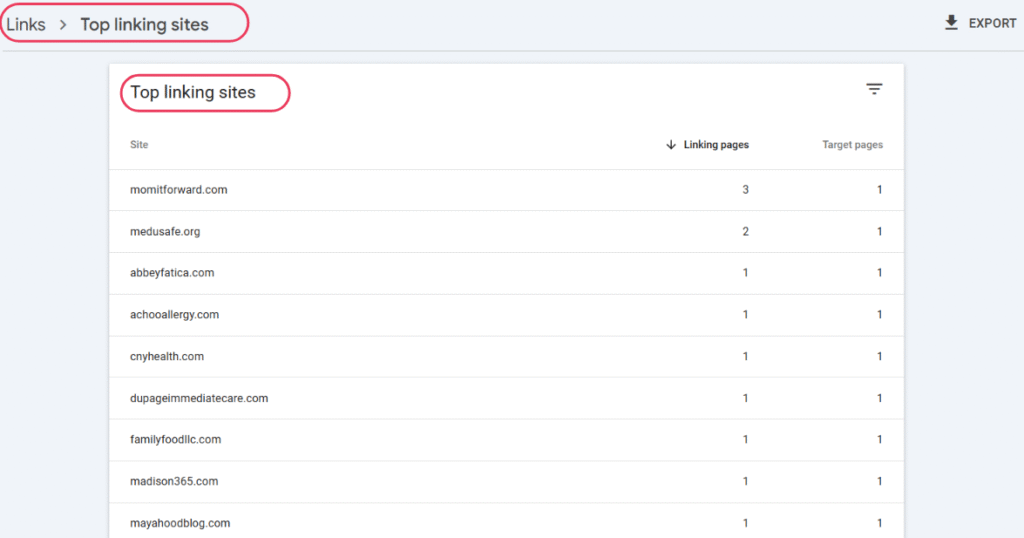
To find your top linked to pages externally, go to your search console and navigate to Links > Top linked pages – externally.
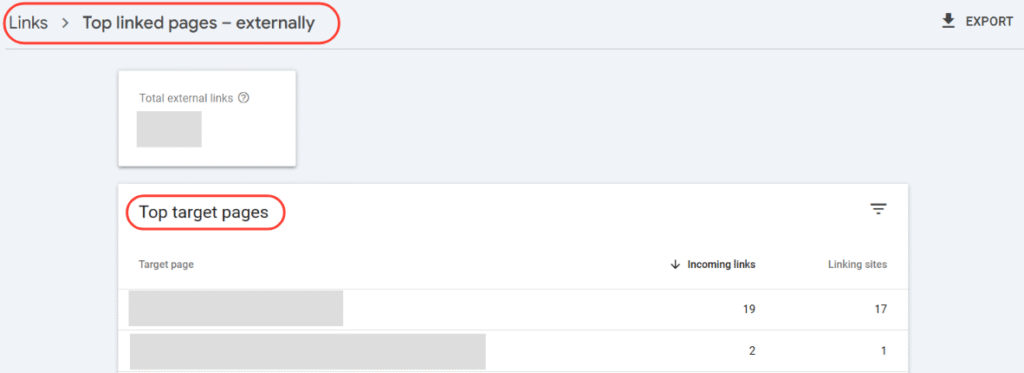
The “Links” report above shows your top linking sites (referring websites or referring domains) and top linked pages (the pages on your website that your referring domains link to the most).
This is your ground-truth source for what Google sees.
Third-Party SEO Tools (Ahrefs, Semrush, Moz)
These platforms are essential for deeper competitive analysis and qualitative metrics.
They provide crucial data points that Google’s tools don’t, such as Domain Authority (DA) or Domain Rating (DR), the distinction between dofollow and nofollow links, and historical backlink data.
For instance, we pulled the referring domains for searchenginejournal.com – which is one of the sites we frequent the most when looking for expert SEO content.
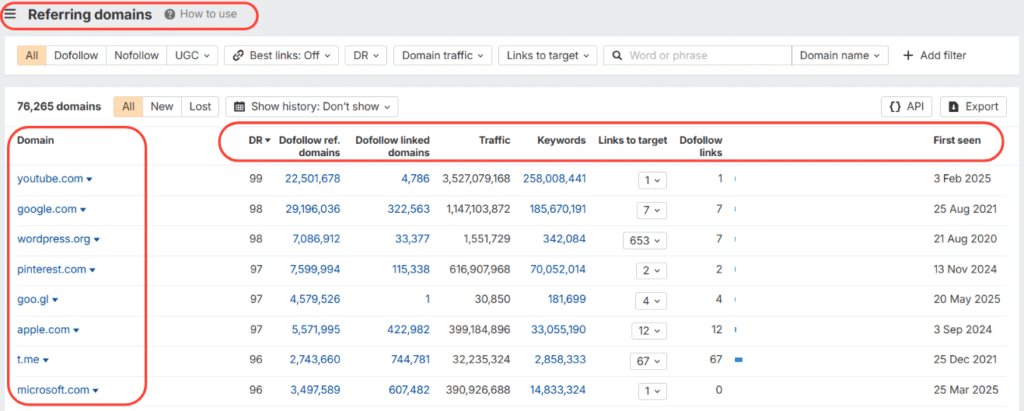
You can see above that the Ahrefs domain checker goes into deeper detail, giving information about:
- The domains,
- The Ahrefs Domain Rating,
- How many are dofollow or nofollow links to SEJ’s website,
- How much traffic those domains have,
- How many keywords do they rank for,
- How many links on each domain to SEJ, and
- When were those links to SEJ first spotted.
Step 2: Segment and Prioritize Your Referrers
Once you have the data, you must segment it to find the most valuable insights.
– Prioritize by Authority
Use a metric like Ahrefs’ Domain Rating (DR) or Moz’s Domain Authority (DA) to sort your referring websites
In the past, a backlink from a DR 85 news site was exponentially more valuable for SEO than a link from a DR 10 personal blog.
However, today it’s just not that simple anymore.
A backlink from a general website that is DR 85 could actually be less valuable than a backlink from a small expert blog that is DR 10.
Why is that so?
Because in the age of AI search, topical authority, expertise and semantic relevance have become more powerful than lame metrics like Domain Authority or Domain Rating.
Both the traditional search engines like Google and Bing and the AI search engines like ChatGPT and Gemini value the popular E-E-A-T framework which stands for: Experience, Expertise, Authoritativeness, and Trustworthiness
For example, if you run an IV Therapy Clinic, a backlink from a website like ivtherapyzone.com which is super focused on the IV Therapy niche can be more powerful than a backlink from the CNN pages just because of how much topical authority IV Therapy Zone has especially in the context of AI search.
Knowing this, you should then go deep into analyzing your linking websites to ensure that you identify your most powerful referrers that you should protect and nurture.
– Filter by Link Attributes (dofollow vs. nofollow):
A dofollow link is the default type and passes “link equity” or “SEO juice” from the referring site to yours, directly impacting your search rankings.
A nofollow link includes a rel="nofollow" attribute, which tells search engines not to pass authority.
Nofollow links can still drive valuable traffic and increase brand visibility. If anything, in the current age of AI Search Engine Optimization, nofollow are very valuable too because they help with brand visibility inside the answer engines and LLMs like ChatGPT, Gemini, and others.
– Analyze by Relevance
As explained above, relevance is more important now than ever before.
A link from a website that is topically aligned with yours is a much stronger signal to Google and LLMs than a link from an irrelevant site.
A plumbing company receiving a link from a home improvement blog is a highly relevant endorsement.
A link from a celebrity gossip site to the same plumbing site is less valuable.
Step 3: Turn Analysis into Actionable Strategy
Now, you can leverage these insights to build a proactive strategy.
– Optimize Your Content Strategy:
Identify the common themes and formats among your most-linked-to pages.
If data-rich articles are your top performers, invest in original research.
If free tools attract high-authority links, prioritize their development.
Use this knowledge to create more content that your ideal referring websites will want to link to.
– Refine Your Link-Building Efforts:
- Lookalike Outreach: Build a list of websites that are similar to your top referrers. Since you know they value content like yours, you can pitch your best assets to them with a higher chance of success.
- Unlinked Mention Monitoring: Set up Google Alerts or use a brand monitoring tool to find mentions of your brand name that don’t include a link. A simple, polite outreach email asking to add a link to the mention has a very high success rate.
- Broken Link Building: Use an SEO tool to find broken external links on authoritative websites in your niche. If you have a relevant piece of content, you can reach out to the site owner, inform them of the broken link, and suggest your content as a superior replacement.
How to Handle Spammy Referrers and Bots
Not all referrers are beneficial.
You will inevitably encounter “referral spam,” where bots or low-quality sites send fake traffic to your site to appear in your analytics reports.
The goal is to get you to visit their shady website out of curiosity.
Key red flags include:
- Irrelevant or nonsensical domain names (e.g.,
free-traffic-4u.xyz). - A sudden, unexplained spike in traffic from one source.
- Analytics showing a 100% bounce rate and 0 seconds average session duration from a referrer.
The best way to handle this is to create a filter in Google Analytics to exclude traffic from these known spam domains.
This Google answer gives a detailed step-by-step guide for creating filters in Google Analytics views.
For genuinely toxic backlinks from malicious sites (which is different from referral spam), Google’s Disavow Tool exists.
However, this should be used as a last resort and only by experienced SEO professionals, as improper use (like disavowing the wrong domains) can harm your site’s rankings.
Conclusion
Your referring websites are far more than a simple list in an analytics report.
They are a living roadmap that reveals your content strengths, your most valuable relationships, and your greatest strategic opportunities.
By moving from passive observation to active analysis, you can deconstruct this data to build a more powerful SEO strategy, create content that earns authoritative links, and forge partnerships that drive sustainable growth.
Following the trail of breadcrumbs left by your referrers is one of the smartest and most effective ways to dominate the search landscape.
And remember to tailor your strategy for AI Search visibility too as discussed above.
